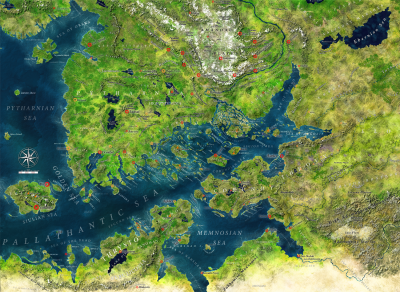Difference between revisions of "Asdar"
Trismegistus (talk | contribs) m |
Trismegistus (talk | contribs) m |
||
| Line 1: | Line 1: | ||
Asdar is name of the World of Asdar and is found as a wander-word throughout the languages of the [[Pallathantic|Pallathantic Region]]. The name 'Asdar' is thought to originate from an Ancient Gwenyan word for 'branch' or from the name of a tribe of [[Elamahti]]. Ancient tradition says that it is called a branch, meaning a 'branch' of [[Kuol Tuvahr]] or the cosmic urwelt from which all [[titans]], [[human]], and [[humanlike]] civilizations sprang. | Asdar is name of the World of Asdar and is found as a wander-word throughout the languages of the [[Pallathantic|Pallathantic Region]]. The name 'Asdar' is thought to originate from an Ancient Gwenyan word for 'branch' or from the name of a tribe of [[Elamahti]]. Ancient tradition says that it is called a branch, meaning a 'branch' of [[Kuol Tuvahr]] or the cosmic urwelt from which all [[titans]], [[human]], and [[humanlike]] civilizations sprang. | ||
| + | |||
| + | [[File:Asdar Pallathantic JMS.png|thumb|400px|The Pallathantic Region of Asdar by map artist Joshua Morley-Smith]] | ||
Asdar is recognized by all civilizations to be ancient beyond the reckoning of human history or even dwarven history. Asdar's size and climate are very similar if not identical to Earth. | Asdar is recognized by all civilizations to be ancient beyond the reckoning of human history or even dwarven history. Asdar's size and climate are very similar if not identical to Earth. | ||
| Line 5: | Line 7: | ||
Humans do not agree regarding their origins on the world of Asdar. The two prevailing and contentious points of view are that the gods created humans on Asdar and that the Titans brought humans to Asdar no less than 20,000 years ago. A version of the former is widely held by most religions of Asdar while the latter is most prevalent among scholars although it is by no means the dominant view in the institutions of higher learning of the [[Pallathantic Region|Pallathantic]]. Alternative and mixed theories also exist, but they are not as widely adopted as the [[titanist]] and the [[autochthonist]] theories. | Humans do not agree regarding their origins on the world of Asdar. The two prevailing and contentious points of view are that the gods created humans on Asdar and that the Titans brought humans to Asdar no less than 20,000 years ago. A version of the former is widely held by most religions of Asdar while the latter is most prevalent among scholars although it is by no means the dominant view in the institutions of higher learning of the [[Pallathantic Region|Pallathantic]]. Alternative and mixed theories also exist, but they are not as widely adopted as the [[titanist]] and the [[autochthonist]] theories. | ||
| + | The mortals of the world of Asdar often see their mother planet as divine and worship many divinities. Many civilizations see the earth goddess as [[Feath Magdaia]] and her companion, [[Knomos]], as the god of the dark depths. | ||
| + | |||
| + | =World Map= | ||
[http://wiki.worldofasdar.com/PDFs/Asdarah_Old_World_%5b1inchto80mi_scale%5d.pdf World of Asdar Old World] | [http://wiki.worldofasdar.com/PDFs/Asdarah_Old_World_%5b1inchto80mi_scale%5d.pdf World of Asdar Old World] | ||
Revision as of 19:11, 7 June 2020
Asdar is name of the World of Asdar and is found as a wander-word throughout the languages of the Pallathantic Region. The name 'Asdar' is thought to originate from an Ancient Gwenyan word for 'branch' or from the name of a tribe of Elamahti. Ancient tradition says that it is called a branch, meaning a 'branch' of Kuol Tuvahr or the cosmic urwelt from which all titans, human, and humanlike civilizations sprang.
Asdar is recognized by all civilizations to be ancient beyond the reckoning of human history or even dwarven history. Asdar's size and climate are very similar if not identical to Earth.
Humans do not agree regarding their origins on the world of Asdar. The two prevailing and contentious points of view are that the gods created humans on Asdar and that the Titans brought humans to Asdar no less than 20,000 years ago. A version of the former is widely held by most religions of Asdar while the latter is most prevalent among scholars although it is by no means the dominant view in the institutions of higher learning of the Pallathantic. Alternative and mixed theories also exist, but they are not as widely adopted as the titanist and the autochthonist theories.
The mortals of the world of Asdar often see their mother planet as divine and worship many divinities. Many civilizations see the earth goddess as Feath Magdaia and her companion, Knomos, as the god of the dark depths.
World Map
See Also
| This article is a stub. It requires further development by the creator. |
